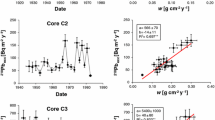Abstract
The last few years have seen a dramatic growth in the use of 210Pb sediment dating. Despite this, considerable doubt still surrounds the nature of the processes by which 210Pb is deposited in lake sediments, and this has lead to a situation where there is a choice of dating models offering different interpretations of 210Pb data. In assessing 210Pb data it is therefore essential to first of all determine whether data is consistent with the assumptions of the dating model, and to then compare the 210Pb chronology with independent dating evidence. We have tested 210Pb data from a wide variety of sites, and our calculations indicate that the crs (constant rate of 210Pb supply) model provides a reasonably accurate chronology when the total 210Pb contents of cores from neighbouring locations are comparable.
Similar content being viewed by others
References
Appleby, P. G. & Oldfield, F., 1978. The calculation of lead-210 dates assuming a constant rate of supply of unsupported 210Pb to the sediment. Catena 5: 1–8.
Appleby, P. G., Oldfield, F., Thompson, R., Huttunen, P. & Tolonen, K., 1979. 210Pb dating of annually laminated lake sediments from Finland. Nature 280: 53–55.
Benninger, L. K., Lewis, D. M. & Turekian, K. K., 1975. The use of natural 210Pb as a heavy metal tracer in the river estuarine system. In: T. M. Church (ed.). Marine Chemistry in the Coastal Environment. Am. Chem. Soc. Symp. Ser. 18: 202–210.
Durham, R. W. & Joshi, S. R., 1980. Recent sedimentation rates, 210 Pb fluxes, and particle settling velocities in Lake Huron, Laurentian Great Lakes. Chem. Geol. 31: 53–66.
Edgington, D. N. & Robbins, J. N., 1976. Pattern of deposition of natural and fall-out radionuclides in the sediments of Lake Michigan and their relation to Limnological processes. In: Nriagu, J. O. (Ed.). Environmental Biogeochemistry, 2. Ann. Arbor Science, M.I.: 705–729.
Elner, J. & Wood, C., 1980. The history of two linked but contrasting lakes in N. Wales from a study of pollen, diatoms and chemistry in sediment cores. J. Ecol. 68: 95–121.
Goldberg, E. D., 1963. Geochronology with 210Pb. In: Radioactive Dating. Int. Atom. Energy Ag. Vienna: 121–131.
Koide, M., Bruland, K. W. & Goldberg, E. D., 1973. Th228/ Th-232 and Pb-210 geochronologies in marine and lake sediments. Geochim. Cosmochim. Acta 37: 1171–1187.
Krishnaswamy, S., Lal, D., Martin, J. M. & Meybeck, M., 1971. Geochronology of lake sediments. Earth planet. Sci. Lett. 11: 407–414.
Krishnaswamy, S. & Lal, D., 1978. Radionuclide Limnochronology. In: Lerman, A. (Ed.). Lakes, Chemistry, Geology & Physics. Springer Verlag, N.Y.: 153–177.
Olfield, F. & Appleby, P. G., in press. Empirical testing of 210Pb dating models for lake sediments. In: Haworth, E. Y. & Lund, J.W. G. (Eds.). Lake Sediments and Environmental History. Leicester Univ. Press.
Oldfield, F., Appleby, P. G. & Petit, D., 1980. A re-evaluation of lead-210 chronology and the history of total lead influx in a small South Belgian Pond. Ambio 9: 97–99.
Oldfield, F., Appleby, P. G. & Battarbee, R. W., 1978. Alternative 210Pb dating: results from the New Guinea Highlands and Lough Erne. Nature 271: 339–442.
Pennington, W., Cambray, R. S., Eakins, J. D. & Harkness, D. D., 1975. Radionuclide dating of the recent sediments of Blelham Tarn. Freshwat. Biol. 6: 317–331.
Petit, D., 1974. Pb-210 et isotopes stables du plomp dans des sediments lacustres. Earth planet. Sci. Lett. 23: 199–205.
Robbins, J. A., 1978. Geochemical and geophysical applications of radioactive lead. In: Nriagu, J. O. (Ed.). Biogeochemistry of Lead in the Environment. Elsevier Scientific, Amsterdam: 285–393.
Robbins, J. A. & Edgington, D. N., 1975. Determination of recent sedimentation rates in Lake Michigan using 210Pb and Cs-137. Geochim. Cosmochim. Acta. 39: 285–304.
Robbins, J. A., Krezoski, J. R., Mozley, S. C., 1977. Radioactivity in sediments of the Great Lakes: Post-depositional redistribution by deposit-feeding organisms. Earth planet. Sci. Lett. 36: 325–333.
Schell, W. R., 1977. Concentrations, physico-chemical states and mean residence times of 210Pb and 210Po in marine and estuarine waters. Geochem. Cosmochim. Acta. 41: 1019–1031.
Author information
Authors and Affiliations
Rights and permissions
About this article
Cite this article
Appleby, P.G., Oldfieldz, F. The assessment of 210Pb data from sites with varying sediment accumulation rates. Hydrobiologia 103, 29–35 (1983). https://doi.org/10.1007/BF00028424
Issue Date:
DOI: https://doi.org/10.1007/BF00028424




